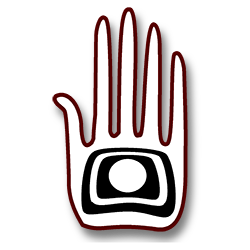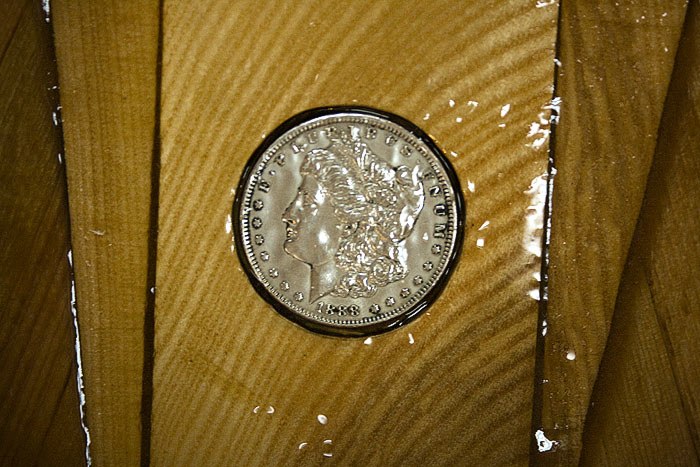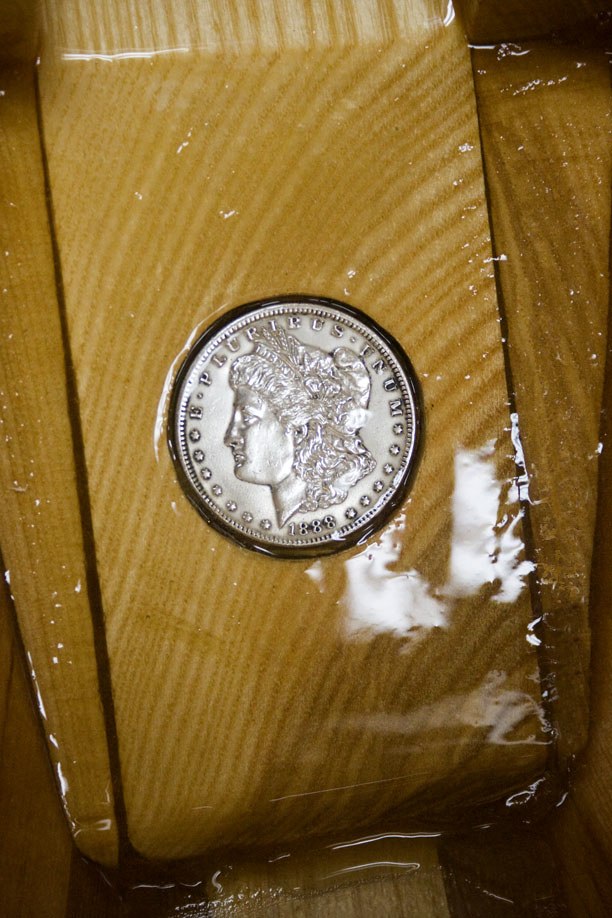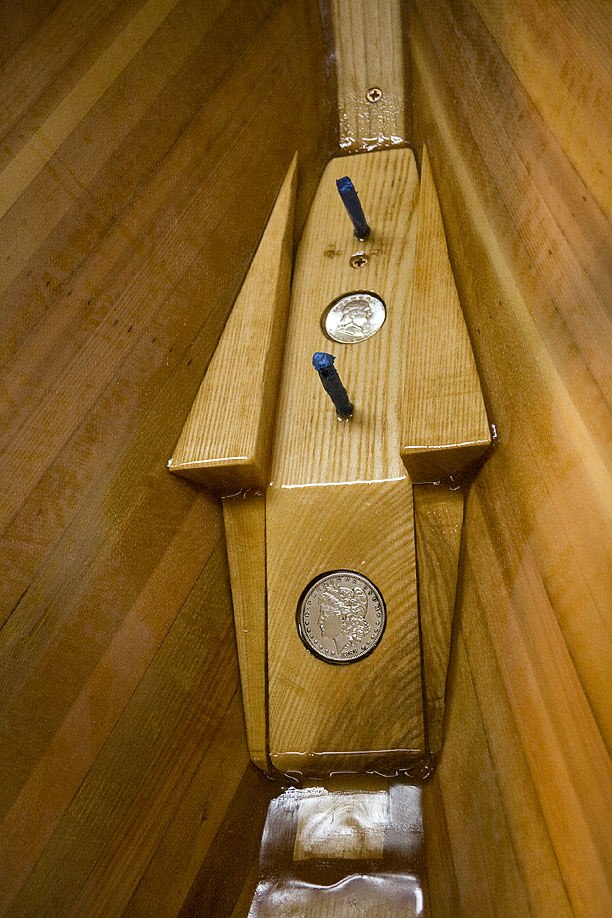A Morgan Dollar, epoxied in place.
Traditions die hard among watermen. Sailors and shipwrights have been putting coins under masts of ships for several thousand years, and still do today. They’ve been found in the mast steps of ancient Roman shipwrecks, even recently. The hope, still, is the offering will bring good luck and safe passage. The original practice had much in common with the consecration of ancient Greek temples as construction began and, more eerily perhaps, putting coins in the mouths of the dead before burial. It was believed that you had to pay the ferryman, Charon, to take your soul across the River Styx to your final resting place in the underworld. Otherwise, your soul would be doomed to wander the earth. A silver coin was preferred, usually an Obolus, placed under the tongue.
I need all the luck I can get, but I’m fresh out of Obols, so which coin to use?
Like many guys of my generation, I had a coin collection when I was young. It wasn’t anything fancy – just old, interesting or unusual coins found in circulation. My dad would save anything odd he got back in pocket change and bring it home for me, and mom, too. Lot’s of wheat pennies, steel pennies, some silver dimes and the occasional half dollar.
Buffalo nickels were especially prized. Without exception, all the other coins and bills in regular circulation then were stamped with images of dead presidents and dull government buildings. Really boring stuff. This made Buffalo nickels unique. Not only did they have that cool stoic buffalo on the back, but a very impressive looking Indian brave on the front, and finding one never failed to fire an active imagination with thoughts of the wild west.
My brother and I spent endless hours playing Cowboys and Indians. With a couple of Buffalo nickels jingling in my pocket, a cowboy hat and boots, kerchief, a vest my mom made, and my Colt 45 cap gun, the whole world (or at least the woods around our neighborhood) got transformed into wild vistas along the Oregon Trail. Bicycles became horses, family dogs were cattle (“get along little doggie”), and cats were mountain lions. We constantly practiced several key moments in western movie drama, like sneaking up on other kids in ambush, quick-draw gunfights, and at the end of a hard day, we’d swagger into a saloon, slap down a Buffalo nickel on the bar and order “whiskey.” It was very important to get all the timing and moves just right, along with the drawl, and often spurred paroxysms of laughter.
Other relatives found out about my collection and made contributions, too. Both grandfathers sent Half Dollars at Christmas, or saved them for our next visit. Relatives who travelled abroad would send back leftover unexchanged money, so there was an international flavor, too. Even when the coins were boring, knowing that this thing I held in my hand had only lately left some distant foreign land made them like little windows into imagined places. My parents once took a trip to the Bahamas and brought back some money for me. The bills, printed in full vibrant color of an underwater coral reef scene, complete with tropical fish, are to this day the most beautiful I’ve ever seen. On a business trip to the Orient, they brought back strange Chinese coins with holes in the centers, like ox cart wheels.
My favorite was a Morgan Dollar. A nice cashier at the Ben Franklin didn’t have a slot for it in her drawer, so she let us have it.
For the most part, though, my coins were found locally. I grew up on the fringes of rural areas in the Deep South and Appalachia. Money was, and still is, dear in those places, and coins were often saved for a very long time, for very special occasions. A lot of people lived back in the hollows who just barely weathered the Great Depression, and they held a deep distrust of banks, so it was not uncommon for people to secret away mason jars and cigar boxes full of coins like acorns for a hard winter. Paper folding money was not used for this purpose, not only because it could rot away to nothing, or be eaten by mice, but many people still had handfuls of worthless Confederate scrip, and paper money was still regarded with disdain. So it was not unheard of to get a very old coin now and then in your change, when someone found a need to spend a bit of their nest egg, or cleaned out a dead relative’s house.
Most of these coins were in such poor condition they were of no value to real collectors. Some were warn smooth as tiddlywinks, and it took a keen eye, and often a magnifying glass, to determine what they were. I had several coins from the mid 1800’s like this – a shield nickel, a two cent piece, and some Seated Liberty’s in small denominations.
But my favorite was a Morgan Dollar. A nice cashier at the Ben Franklin didn’t have a slot for it in her drawer, so she let us have it. It was the only true silver dollar in my collection. Later, I had some new Eisenhowers, but they were neither old nor even silver. The Morgan Dollar was the real thing. It was heavy like a doubloon, it tarnished like silver should, and it was from the late 1800’s – a whole nother century ago – and it’s markings, though worn, were still clearly visible.
Funny thing is, I don’t know where my coin collection is now. I may have given it away to another little boy just starting his own collection, I honestly can’t remember. But as time approached to put a coin in each step under these masts, it kind of brought back all those memories.
Many boat builders use coins with some significance personally, such as one from their birth year or someone else’s. I couldn’t make up my mind. I ended up using two for each boat – a Benjamin Half from the year I was born, and a Morgan Dollar, like the one I had as a boy, from 1888, the approximate year the plans for these boats were born. They’re not very valuable. One looks like it was once part of a necklace or something, with tiny holes along the rim. Another must have spent decades stuck to a piece of cardboard, as it still has glue on the back. But they’ll add a sparkle in the darkest corner of the boats. They’ll wink at anyone who opens the forward hatch or pulls a mast, and for me they’ll be a little reminder of some good memories.
So the mast steps are now glued and screwed in place, with enough epoxy to fill all the gaps of the ill-fitting oddball shapes. They definitely look better than expected. Maybe all the shiny just adds enough distraction you don’t notice so much. As long as they hold I’ll be happy.
melonseed skiff, mellonseed skiff, melon seed, mellon seed






I feel so cheap! I used a 1919 penny. You have done a great job and the coins are a classy touch. I hope to see to your handiwork at St Micheals in Oct.
Regards,
Tom Reppert
Wednesday, June 9, 2010 – 03:37 PM
Hey Tom, and thanks. I’m really looking forward to St. Mikes this year, too.
The coins look pretty swanky, but a single box of bronze screws set me back more than all the coins combined. Makes you want to polish the screw heads and leave them where they’ll sparkle, instead.
Barry
Wednesday, June 9, 2010 – 10:14 PM
Beautiful stuff really. I’ve been reading all the posts lately. There’s so much in this blog it’s amazing. The stills, the craftmanship, the story’s and you really get to know the handyman behind all this. Big thumbs up! I’m from an other part off the world (Belgium) and you really got me interested in these little beautiful sailing crafts.
Friday, June 11, 2010 – 06:55 AM
Thanks, Maarten. I was in Belgium once a long time ago, and really loved it. It’s one of the places I hope to return to and spend more time exploring. The whole coast from Brittany to Norway is so beautiful and varied, and I’ve seen so little of it.
Barry
Sunday, June 13, 2010 – 12:28 AM
I’ve been trying to find out about the practice of putting a silver coin in the bilge for good luck when changing the name of a boat, but what I’ve been finding is that this practice is for sailing vessels and it means safe passage and has nothing to do with changing the name of a boat. Can you tell me if you know if this applies to name change as well and where are you supposed to place the coin if it’s a power boat and not a sailboat….no masthead…hmmmm
thanks
Kathy
Hi Kathy,
In the Navy, they still put coins on the ships, under the radar “mast”. It’s for good luck in general. Changing the name of a boat is supposedly bad luck, so there are certain libations poured and offerings made to appease the gods. The coins would be an equalizing offset. (If you happen to be superstitious 😉 )